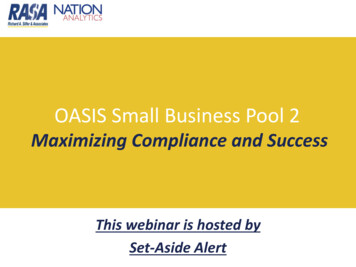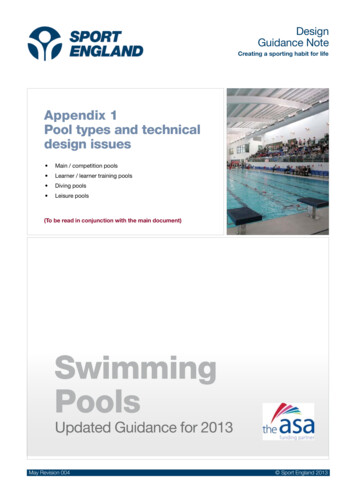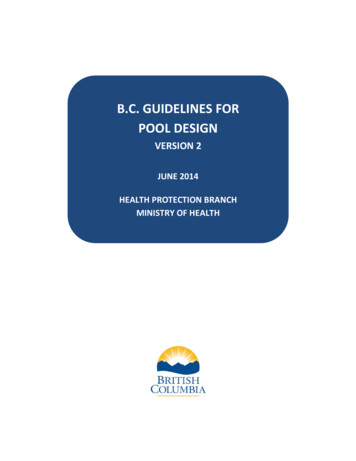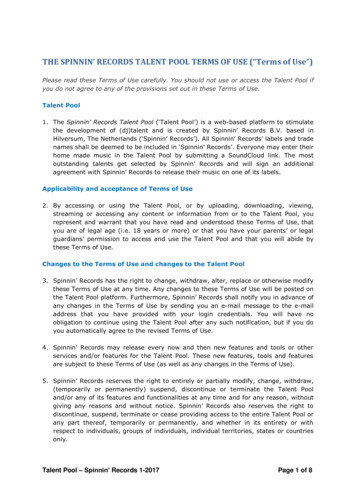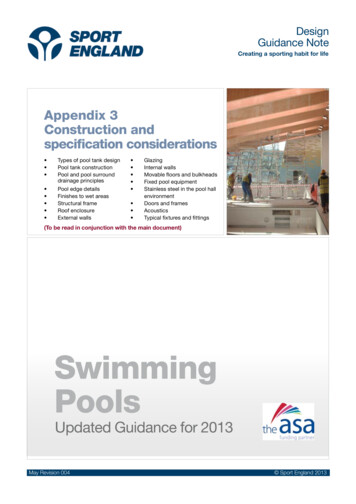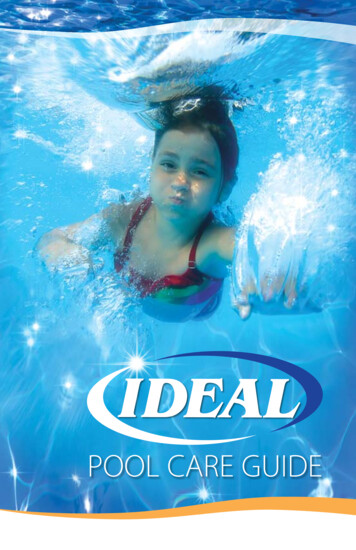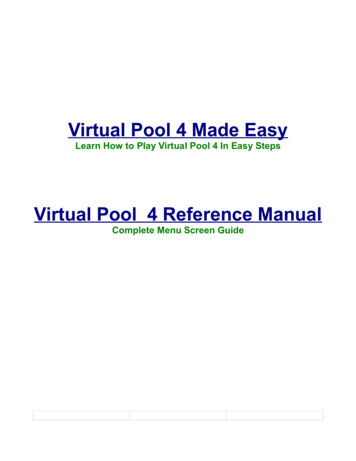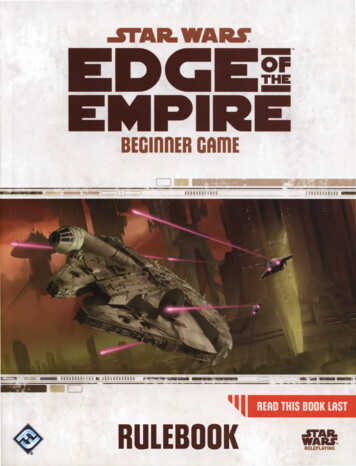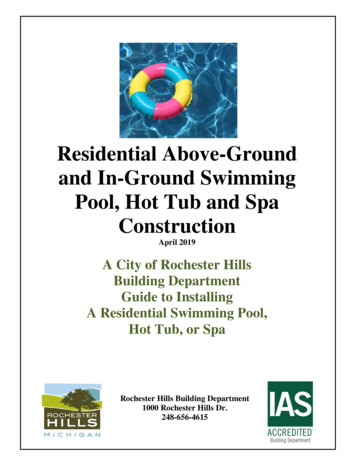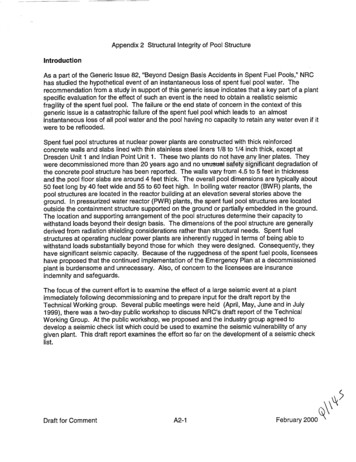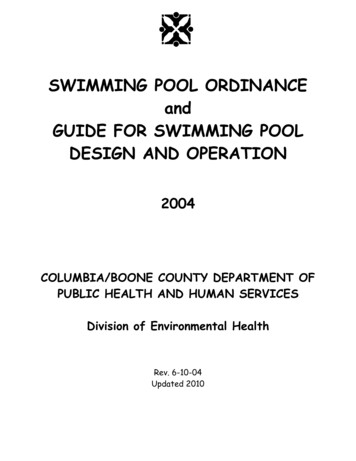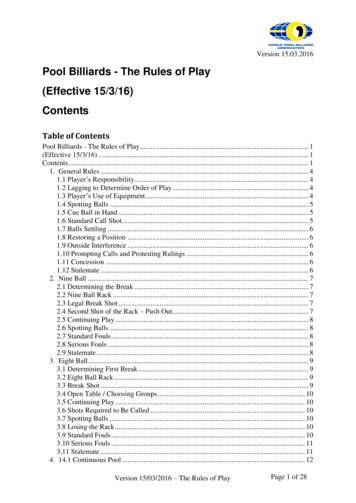
Transcription
Version 15.03.2016Pool Billiards - The Rules of Play(Effective 15/3/16)ContentsTable of ContentsPool Billiards - The Rules of Play . 1(Effective 15/3/16) . 1Contents . 11. General Rules . 41.1 Player’s Responsibility . 41.2 Lagging to Determine Order of Play . 41.3 Player’s Use of Equipment . 41.4 Spotting Balls . 51.5 Cue Ball in Hand . 51.6 Standard Call Shot . 51.7 Balls Settling . 61.8 Restoring a Position . 61.9 Outside Interference . 61.10 Prompting Calls and Protesting Rulings . 61.11 Concession . 61.12 Stalemate . 62. Nine Ball . 72.1 Determining the Break . 72.2 Nine Ball Rack . 72.3 Legal Break Shot . 72.4 Second Shot of the Rack – Push Out. 72.5 Continuing Play . 82.6 Spotting Balls . 82.7 Standard Fouls . 82.8 Serious Fouls . 82.9 Stalemate . 83. Eight Ball. 93.1 Determining First Break . 93.2 Eight Ball Rack . 93.3 Break Shot . 93.4 Open Table / Choosing Groups . 103.5 Continuing Play . 103.6 Shots Required to Be Called . 103.7 Spotting Balls . 103.8 Losing the Rack . 103.9 Standard Fouls . 103.10 Serious Fouls . 113.11 Stalemate . 114. 14.1 Continuous Pool . 12Version 15/03/2016 – The Rules of PlayPage 1 of 28
Version 15.03.20164.1 Lagging for the Break . 124.2 The 14.1 Rack . 124.3 Opening Break Shot . 124.4 Continuing Play and Winning the Game . 124.5 Shots Required to Be Called . 124.6 Spotting Balls . 124.7 Scoring . 124.8 Special Racking Situations . 134.9 Standard Fouls . 134.10 Breaking Foul . 144.11 Serious Fouls . 144.12 Stalemate . 145. Black Ball . 155.1 Definitions . 15Free shot . 15Baulk . 15Snookered . 15Ball On . 155.2 Equipment . 155.3 Determining First Break . 155.4 Black Ball Rack . 165.5 Break Shot . 165.6 Open Table / Choosing Groups . 165.7 Continuing Play . 165.8 Cue Ball in Hand in Baulk . 165.9 Touching Balls . 165.10 Playing from a Snooker . 165.11 Spotting Balls . 175.12 Stalemate . 175.13 Standard Fouls . 175.14 Loss of Rack Fouls . 176. Fouls . 186.1 Cue Ball Scratch or off the Table . 186.2 Wrong Ball First . 186.3 No Rail after Contact . 186.4 No Foot on Floor . 186.5 Ball Driven off the Table . 186.6 Touched Ball . 186.7 Double Hit / Frozen Balls. 186.8 Push Shot . 196.9 Balls Still Moving . 196.10 Bad Cue Ball Placement . 196.11 Bad Play from Behind the Head String . 196.12 Cue Stick on the Table . 196.13 Playing out of Turn . 196.14 Three Consecutive Fouls . 196.15 Slow Play. 196.16 Ball Rack Template Foul. 206.17 Unsportsmanlike Conduct . 207. Rules/Regulations for Wheelchair Competition . 21Page 2 of 28Version 15/03/2016 – The Rules of Play
Version 15.03.20167.1 Player’s Eligibility. 217.2 Violations Resulting in Fouls . 217.3 Wheelchair Requirements . 218. Definitions Used in the Rules. 228.1 Parts of the Table . 228.2 Shot. 238.3 Ball Pocketed. 238.4 Driven to a Rail . 238.5 Driven off the Table . 238.6 Scratch . 248.7 Cue Ball . 248.8 Object Balls . 248.9 Set . 248.10 Rack . 248.11 Break . 248.12 Inning . 248.13 Position of Balls . 248.14 Re-spotting Balls . 248.15 Restoring a Position . 258.16 Jump Shot . 258.17 Safety Shot . 258.18 Miscue . 259. Ten Ball . 269.1 Determining the Break . 269.2 Ten Ball Rack . 269.3 Legal Break Shot . 269.4 Second Shot of the Rack – Push Out. 269.5 Call Shots & Pocketing Balls . 279.6 Safety . 279.7 Wrongfully Pocketed Balls . 279.8 Continuing Play . 279.9 Spotting Balls . 279.10 Standard Fouls . 279.11 Serious Fouls . 289.12 Stalemate . 28Version 15/03/2016 – The Rules of PlayPage 3 of 28
Version 15.03.20161. General RulesThe following General Rules apply to all the games covered by these rules except whencontradicted by specific game rules. In addition, the Regulations of Pool Billiards coveraspects of the game not directly related to the game rules, such as equipment specificationsand organization of events.The games of Pool Billiards are played on a flat table covered with cloth and bounded byrubber cushions. The player uses a stick (pool cue) to strike a cue ball which in turn strikesobject balls. The goal is to drive object balls into six pockets located at the cushion boundary.The games vary according to which balls are legal targets and the requirements to win amatch.[Editorial comments on the U.S. English version: The masculine gender has been used forsimplicity of wording and is not intended to specify the gender of the players or officials. Theword “game” is used to refer to a discipline such as nine ball rather than a rack or a match.]1.1 Player’s ResponsibilityIt is the player's responsibility to be aware of all rules, regulations and schedules applying tocompetition. While tournament officials will make every reasonable effort to have suchinformation readily available to all players as appropriate, the ultimate responsibility restswith the player.1.2 Lagging to Determine Order of PlayThe lag is the first shot of the match and determines order of play. The player who wins thelag chooses who will shoot first.The referee will place a ball on each side of the table behind the head string and near the headstring. The players will shoot at about the same time to make each ball contact the footcushion with the goal of returning the ball closer to the head cushion than the opponent.A lag shot is bad and cannot win if the shooter’s ball:(a) crosses the long string;(b) contacts the foot cushion other than once;(c) is pocketed or driven off the table;(d) touches the side cushion; or(e) the ball rests within the corner pocket and past the nose of the head cushion.In addition, a lag will be bad if any non-object-ball foul occurs other than 6.9 Balls StillMoving.The players will lag again if:(a) a player’s ball is struck after the other ball has touched the foot cushion;(b) the referee cannot determine which ball has stopped closer to the head cushion; or(c) both lags are bad.1.3 Player’s Use of EquipmentThe equipment must meet existing WPA equipment specifications. In general, players are notpermitted to introduce novel equipment into the game. The following uses, among others, areconsidered normal. If the player is uncertain about a particular use of equipment, he shoulddiscuss it with the tournament management prior to the start of play. The equipment must beused only for the purpose or in the manner that the equipment was intended. (See 6.17Unsportsmanlike Conduct.)Version 15/03/2016 – The Rules of PlayPage 4 of 28
Version 15.03.2016(a) Cue Stick – The player is permitted to switch between cue sticks during the match, such asbreak, jump and normal cues. He may use either a built-in extender or an add-on extender toincrease the length of the stick.(b) Chalk – The player may apply chalk to his tip to prevent miscues, and may use his ownchalk, provided its color is compatible with the cloth.(c) Mechanical Bridges – The player may use up to two mechanical bridges to support the cuestick during the shot. The configuration of the bridges is up to the player. He may use his ownbridge if it is similar to standard bridges.(d) Gloves – The player may use gloves to improve the grip and/or bridge hand function.(e) Powder – A player is allowed to use powder in a reasonable amount as determined by thereferee.1.4 Spotting BallsBalls are spotted (returned to play on the table) by placing them on the long string (long axisof the table) as close as possible to the foot spot and between the foot spot and the foot rail,without moving any interfering ball. If the spotted ball cannot be placed on the foot spot, itshould be placed in contact (if possible) with the corresponding interfering ball. However,when the cue ball is next to the spotted ball, the spotted ball should not be placed in contactwith the cue ball; a small separation must be maintained. If all of the long string below thefoot spot is blocked by other balls, the ball is spotted above the foot spot, and as close aspossible to the foot spot.1.5 Cue Ball in HandWhen the cue ball is in hand, the shooter may place the cue ball anywhere on the playingsurface (see 8.1 Parts of the Table) and may continue to move the cue ball until he executes ashot. (See definition 8.2 Shot.) Players may use any part of the cue stick to move the cue ball,including the tip, but not with a forward stroke motion. In some games and for most breakshots, placement of the cue ball may be restricted to the area behind the head string dependingon the rules of the game, and then 6.10 Bad Cue Ball Placement and 6.11 Bad Play fromBehind the Head String may apply.When the shooter has the cue ball in hand behind the head string and all the legal object ballsare behind the head string, he may request the legal object ball nearest the head string to bespotted. If two or more balls are equal distance from the head string, the shooter maydesignate which of the equidistant balls is to be spotted. An object ball that rests exactly onthe head string is playable.1.6 Standard Call ShotIn games in which the shooter is required to call shots, the intended ball and pocket must beindicated for each shot if they are not obvious. Details of the shot, such as cushions struck orother balls contacted or pocketed are irrelevant. Only one ball may be called on each shot.For a called shot to count, the referee must be satisfied that the intended shot was made, so ifthere is any chance of confusion, e.g. with bank, combination and similar shots, the shootershould indicate the ball and pocket. If the referee or opponent is unsure of the shot to beplayed, he may ask for a call.In call shot games, the shooter may choose to call “safety” instead of a ball and pocket, andthen play passes to the opponent at the end of the shot. Whether balls are being spotted aftersafeties depends on the rules of the particular game.Version 15/03/2016 – The Rules of PlayPage 5 of 28
Version 15.03.20161.7 Balls SettlingA ball may settle slightly after it appears to have stopped, possibly due to slight imperfectionsin the ball or the table. Unless this causes a ball to fall into a pocket, it is considered a normalhazard of play, and the ball will not be moved back. If a ball falls into a pocket as the result ofsuch settling, it is restored as closely as possible to its original position. If a settling ball fallsinto a pocket during or just prior to a shot, and this has an effect on the shot, the referee willrestore the position and the shot will be replayed. The shooter is not penalized for shootingwhile a ball is settling. See also 8.3 Ball Pocketed.1.8 Restoring a PositionWhen necessary for balls to be restored or cleaned, the referee will restore disturbed balls totheir original positions to the best of his ability. The players must accept the referee’sjudgment as to placement.1.9 Outside InterferenceWhen outside interference occurs during a shot that has an effect on the outcome of that shot,the referee will restore the balls to the positions they had before the shot, and the shot will bereplayed. If the interference had no effect on the shot, the referee will restore the disturbedballs and play will continue. If the balls cannot be restored to their original positions, thesituation is handled like a stalemate.1.10 Prompting Calls and Protesting RulingsIf a player feels that the referee has made an error in judgment, he may ask the referee toreconsider his call or lack of call, but the referee’s decision on judgment calls is final.However, if the player feels that the referee is not applying the rules correctly, he may ask forruling by the designated appeals authority. The referee will suspend play while this appeal isin process. (See also part (d) of 6.17 Unsportsmanlike Conduct.) Fouls must be calledpromptly. (See 6. Fouls.)1.11 ConcessionIf a player concedes, he loses the match. For example, if a player unscrews his jointed playingcue stick while the opponent is at the table and during the opponent’s decisive rack of amatch, it will be considered a concession of the match.1.12 StalemateIf the referee observes that no progress is being made towards a conclusion, he will announcehis decision, and each player will have three more turns at the table. Then, if the refereedetermines that there is still no progress, he will declare a stalemate. If both players agree,they may accept the stalemate without taking their three additional turns. The procedure for astalemate is specified under the rules for each game.Version 15/03/2016 – The Rules of PlayPage 6 of 28
Version 15.03.20162. Nine BallNine ball is played with nine object balls numbered one through nine and the cue ball. Theballs are played in ascending numerical order. The player legally pocketing the nine ball winsthe rack.2.1 Determining the BreakThe player who wins the lag chooses who will break the first rack. (See 1.2 Lagging toDetermine Order of Play.) The standard format is to alternate the break, but see Regulation16, Subsequent Break Shots.2.2 Nine Ball RackThe object balls are racked as tightly as possible in a diamond shape, with the one ball at theapex of the diamond and on the foot spot and the nine ball in the middle of the diamond. Theother balls will be placed in the diamond without purposeful or intentional pattern.Spot19Nine Ball Rack2.3 Legal Break ShotThe following rules apply to the break shot:(a) the cue ball begins in hand behind the head string;(b) if no ball is pocketed, at least four object balls must be driven to one or more rails, orthe shot is a foul(c) additionally, and only when Three Point Break Rule is used, if no ball is pocketed,three balls must touch the head string, or the break is considered ‘illegal break’. (SeeRegulation 18, Three Point Break Rule.)2.4 Second Shot of the Rack – Push OutIf no foul is committed on the break shot, the shooter may choose to play a “push out” as hisshot. He must make his intention known to the referee, and then rules 6.2 Wrong Ball Firstand 6.3 No Rail after Contact are suspended for the shot. If no foul is committed on a pushout, the other player chooses who will shoot next.Version 15/03/2016 – The Rules of PlayPage 7 of 28
Version 15.03.20162.5 Continuing PlayIf the shooter legally pockets any ball on a shot (except a push out, see 2.4 Second Shot of theRack – Push Out), he continues at the table for the next shot. If he legally pockets the nineball on any shot (except a push out), he wins the rack. If the shooter fails to pocket a ball orfouls, play passes to the other player, and if no foul was committed, the incoming player mustplay the cue ball from the position left by the other player.2.6 Spotting BallsIf the nine ball is pocketed on a foul or push out, or driven off the table, it is spotted. (See 1.4Spotting Balls.) No other object ball is ever spotted.2.7 Standard FoulsIf the shooter commits a standard foul, play passes to his opponent. The cue ball is in hand,and the incoming player may place it anywhere on the playing surface. (See 1.5 Cue Ball inHand) The following are standard fouls at nine ball:6.1 Cue Ball Scratch or off the Table6.2 Wrong Ball First The first object ball contacted by the cue ball on each shot must be thelowest-numbered ball remaining on the table.6.3 No Rail after Contact6.4 No Foot on Floor6.5 Ball Driven off the Table The only jumped object ball that is spotted is the nine.6.6 Touched Ball6.7 Double Hit / Frozen Balls6.8 Push Shot6.9 Balls Still Moving6.10 Bad Cue Ball Placement6.12 Cue Stick on the Table6.13 Playing out of Turn6.15 Slow Play6.16 Ball Rack Template Foul2.8 Serious FoulsFor 6.14 Three Consecutive Fouls, the penalty is loss of the current rack. For 6.17Unsportsmanlike Conduct, the referee will choose a penalty appropriate given the nature ofthe offense.2.9 StalemateIf a stalemate occurs the original breaker of the rack will break again. (See 1.12 Stalemate.)Version 15/03/2016 – The Rules of PlayPage 8 of 28
Version 15.03.20163. Eight BallEight ball is played with fifteen numbered object balls and the cue ball. The shooter’s groupof seven balls (one through seven or nine through fifteen) must all be off the table before heattempts to pocket the eight ball to win. Shots are called.3.1 Determining First BreakThe player winning the lag has the option to determine who has to execute the first break shot.(See 1.2 Lagging to Determine Order of Play.) The standard format is alternate break (SeeRegulation 16, Subsequent Break Shots.)3.2 Eight Ball RackThe fifteen object balls are racked as tightly as possible in a triangle, with the apex ball on thefoot spot and the eight ball as the first ball that is directly below the apex ball. One from eachgroup of seven will be on the two lower corners of the triangle. The other balls are placed inthe triangle without purposeful or intentional pattern.SpotEight Ball Rack3.3 Break ShotThe following rules apply to the break shot:(a) The cue ball begins in hand behind the head string.(b) No ball is called, and the cue ball is not required to hit any particular object ball first.(c) If the breaker pockets a ball and does not foul, he continues at the table, and the tableremains open. (See 3.4 Open Table / Choosing Groups.)(d) If no object ball is pocketed, at least four object balls must be driven to one or more rails,or the shot results in an illegal break, and the incoming player has the op
1. General Rules The following General Rules apply to all the games covered by these rules except when contradicted by specific game rules. In addition, the Regulations of Pool Billiards cover aspects of the game not directly related to the game rules, suc
